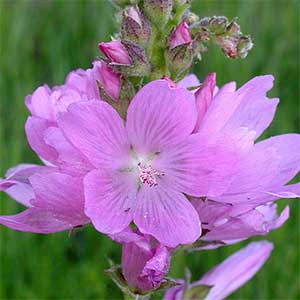Sidalcea oregana var. calva
Sidalcea oregana subsp. eximia
Oregon checkermallow
coast checkerbloom, Humboldt checkerbloom
sometimes rooting at base, usually branched distally, often hollow but firm, base conspicuously densely bristly, hairs simple with swollen base, 1–2.5 mm.
stipules lanceolate, 10–14 × 2 mm;
petioles of basal and proximal leaves (5–)10–20(–30) cm, 3–4+ times as long as blade, reduced distally and distalmost leaves nearly sessile;
blade reniform-orbiculate, cordate, unlobed and margins merely crenate or shallowly 5–7(–9)-lobed, 3–9.5(–12) × 3–13 cm, blades distally all deeply 5–7-lobed essentially to base, hairs simple on both sides, 1–1.5 mm, distalmost blades usually 5-parted with irregularly-toothed lobes.
spiciform, dense, calyces usually overlapping, branched, 20+-flowered, 3–8 cm, little elongating in fruit, flowers and fruits overlapping;
primary peduncles (above distalmost leaf) usually equaling or shorter than mature inflorescence;
bracts linear-lanceolate, undivided, 7 mm, usually longer than young flower buds and conspicuous then, much longer than pedicels, shorter than to nearly equaling calyx.
1–2 mm.
bisexual;
calyx 8–10 mm, to 13 mm in fruit, stellate-puberulent, conspicuously bristly-tomentose especially on base, hairs 1.5–2.5 mm;
petals pink, 15–16 mm;
staminal column 9 mm, hirtellous-hairy;
anthers white;
stigmas 7–9.
2 mm.
5–6 mm diam.;
mericarps 7–9, 2.5 mm, sparsely puberulent with a few bristles, smooth or nearly so, margins rounded, mucro 0.5–0.7 mm.
Sidalcea oregana var. calva
Sidalcea oregana subsp. eximia
Subspecies eximia is uncommon and somewhat obscure. It was recognized by Hitchcock because of its notably accrescent and long-hirsute calyces and its robust habit and narrow range. It clearly intergrades with subsp. spicata and also strongly resembles Sidalcea setosa. There are no recent collections of subsp. eximia and only a limited number of older ones; it may be extirpated. It is known from the northern coast and North Coast Ranges in Humboldt County.
Of conservation concern.
(Discussion copyrighted by Flora of North America; reprinted with permission.)
- Local floras:
WA
- Local Web sites:
Flora NW,
PNW Herbaria
WildflowerSearch
iNaturalist (observations)
- LBJ Wildflower Center
- SEINet
- Plants of the World Online
- Encyclopedia of Life
- Wikipedia
- Google Image Search


